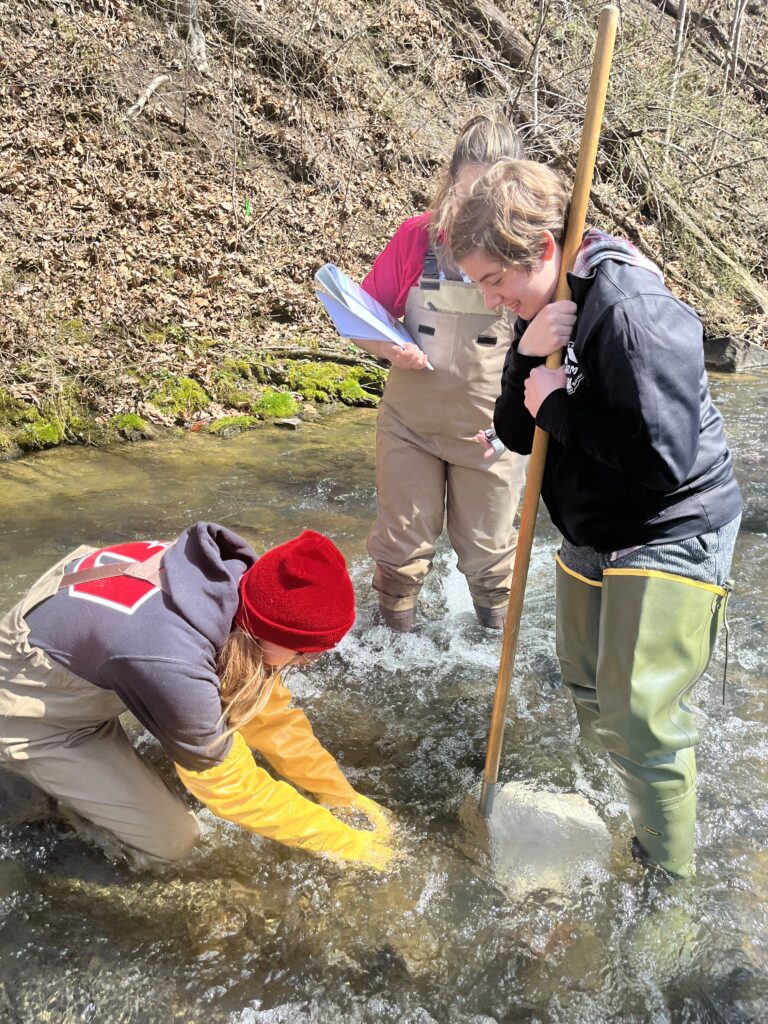On March 29th, we, Amaya and Amelia, participated in our first macro collection as a part of the CMC benthic macroinvertebrate collection protocol. This field experience was one of many taking place in waterways within the Chesapeake Bay to collect samples in areas with little to no data. Assessment of macroinvertebrate communities is integral to understanding waterway health, and so ALLARM is participating in collecting samples from under-monitored waterways.
Until now, Amelia and I have both participated in and/or taught macroinvertebrate collection and identification with local volunteer monitors to assess their own streams. With ALLARM’s typical macroinvertebrate collections, we are used to a specific protocol, so in order to learn this new method, we had to review different steps to ensure our sample was collected with minimal error. Though this macroinvertebrate collection involved more preparation on our end, we were thrilled to try a different collection technique.
Our site was in Doubling Gap Run, a stream running through a rural area in between McCrea and Landisburg, PA. We did our collection in a beautiful, forested spot just off the road, upstream of a bridge.
In many ways, this new method of collecting macroinvertebrates was different from what we were used to. We generally use kick nets and our feet to disturb rocks and the substrate, dislodging macroinvertebrates. For this method, we utilized a D-net and our hands, picking up rocks and cleaning their surfaces with gloves, then disturbing the substrate further by scraping down with a rock. This new protocol also called for six smaller sub-collections to be added together for one entire sample.
Amelia: Due to last-minute schedule changes, I didn’t have much of a chance to study the CMC macroinvertebrate collection protocol prior to leaving for the stream, but Amaya gave me a wonderful crash course on the protocol while we were in the van on the way there. I wasn’t quite sure what to expect going in, but the collection went very well. Once we got to the stream site, it took us a bit of time to find an appropriate spot to begin our collection; however, once we actually got into the stream and finished the first sub-collection, it felt like we had a good handle on the protocol and the remaining five sub-collections went smoothly!
Amaya: I really enjoyed being able to participate in this macroinvertebrate collection. Although this method was different than what I am used to, it was a quick method to pick up and there weren’t any issues in following it. Using our hands to scrub the rocks meant breaking out our new long yellow gloves, and I felt as though being able to pick up and move the rocks with my hands gave me more precision for the macroinvertebrate collection than I am used to with our typical method. We were able to find so many macroinvertebrates, including a green caddisfly which I had never seen in real life before! It was a great day to be out in the field with some of the ALLARM team and we had plenty of fun doing this collection.
Amelia: I don’t have as much experience with macroinvertebrates as Amaya, and it was awesome to get out into the field and learn a new protocol! I had a lot of fun. The green caddisfly was definitely a highlight—we also found orange caddisflies and some freshwater clams. We combined all of our sub-collections into one container, and finished up by storing the combined sample in ethanol for preservation. Since this collection, I’ve had the opportunity to go through the CMC protocol again at a different site, and I hope I’ll be able to do more with macroinvertebrates in the future!
